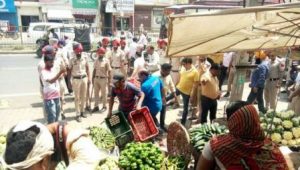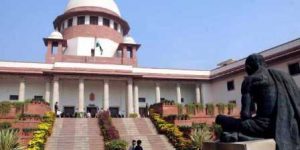Rethinking the Tehbazari Rights in Urban India
Alarming conditions of street vendors continue to raise questions and remain unprotected while struggling to earn a living

In the past few months, an astonishing question on the right to livelihood is being raised by the street vendors/hawkers before Hon’ble High Court of Delhi. The decision of Supreme Court (SC) in the Pyare Lal vs. New Delhi Municipal Committee and Anr, wherein without having any permanent structure, the former used to sell endurable goods on the footpath or allotted spaces as per rules established by the Municipal Corporation on payment of charges described as Tehbazari, and used to sell goods without causing any inconvenience to the pedestrian and local shops was questioned.Considering the threat of the right to livelihood, The SC has once again observed in a judgement that Municipal Corporation doesn’t even comply with the order of the Apex Court except giving false assurance and continually obstructing the Tehbazaris, which lead to infringement of the Article 19(1)(g) of the Constitution as reflected in several other cases. However, the reasonable restriction was also made there under, wherein the Tehbazaris were restrained to sell any goods which may cause any pollution to the society or health disorders and public inconvenience embedded under Article 19(6) of the Constitution.
By Sixteenth Amendment Act, 1963, the sovereignty and integrity of India has been introduced, which resulted in major benefits for the people covering under low-middle-income class. Similarly, the decision made in Kameshwar Prasad and Kharak Singh cases effectuated Article 19 (2) to (6) of the Constitution to regulate the exercise of the right to the freedoms guaranteed by Article 19 (1) (a) to (e) and (g) must be a law having statutory force and not a mere executive or departmentalinstructions as also reflected in the Bijoe Emmanuel case.
The poor Tehbazaris or vendors are harassed and constantly victimized by the officials of the local authorities, the police, etc., who regularly target them for extra income and treat them with extreme contempt.
The goods belonging to Tehbazaris are thrown to the ground and destroyed at regular intervals, if they are unable to meet the demands of the officials. Sometimes, the officials confiscate the goods of the Tehbazari without having an order of the higher official or issuing any seizure memo and impose a heavy penalty upon the goods being seized at the time of releasing seized goods, for which loss has to be borne by the Tehbazari.
Determining the ratio of Sodan Singh case, various Petitions were filed before the Apex Court impugning the order of the High Court, wherein the weekly market has been obstructed by the local authorities. Thareja Committee, as well as the salient features of NDMC scheme, states that squatters up to 1977 shall be eligible for the allotment of a kiosk while the squatters from 1978 to 980 shall be eligible for Tehbazari site, if no shop/kiosk is available. The squatters squatting from 1981 to1987 shall be considered for allotment for a Tehbazari site subject to availability of vacant space. However, Thareja Committee examined 5,627 claims in great detail and found that 761 out of 5,627 persons were entitled to allotment of sites, including12 cases of hardship. The said Committee also identified 977 sites for squatting in the NDMC area.
Also Read : Artificial Intelligence The Solution To Reducing Backlogs In Indian Courts
In 2004, the Union of India has brought a National Policy on Urban Street Vendors(NPSV) considering the poor status of the Tehbazari and class of citizenry in purview of Gurnam Kaur case, wherein it was agreed to establish ward vending committees who will assist the Municipal Corporation to identify the hawking and non-hawking zones held in consultation with various stakeholders likes vendors/traders’ associations, resident welfare associations,traffic police, etc. in accordance with the relevant rules. In addition, it was established that the total vending sites would not exceed 2.5 percent of the total population of that particular ward/zone based on census 2001, and about 3 lakhs hawkers/squatters could be accommodated including existing Tehbazari vending sites.
Delhi Laws Special Provisions Act, 2007 as a Central law has achieved primacy over the administrative orders but was applicable only till December 2009. With the NPSV, the photo census of all the squatters and hawkers so as to avoid all illegal transfers of such sites in future has also been opined by Court. In addition, compliance to NPSV, a survey for the purpose of allotment of vending site to the Tehbazari was introduced which failed as numerous petitionsagainst them have been instituted in various forum as evidenced from Maharashtra Ekta Hawkers, wherein the Apex Court emphasising the poor conditions of millions of people in urban city prioritize the Tehbazari, who procure their basic necessities mainly from Tehbazari because the goods sold on pavements or through pushcarts are always lower in price.With this, the Court itself regret to find a workable solution of the problems of Tehbazari, the weaker sections of society as well as residents of localities/places where Tehbazari operate. Every time the Court delivered judgments/directions, it recognized street vending in view to earn a livelihood as the fundamental right of each citizen.
It is undeniable that the authorities did not take a step on allocating the vending site to the Tehbazari but such allocation out of bazaar is not a solution.

Overwhelmingly, the legislature has introduced the Street Vendors (Protection of Livelihood and Regulation of Street Vending) Act, 2014, which provides enforcement of laws on the street vendors/hawkers, wherein no Tehbazari shall be evicted or relocated till the survey to be carried out by the Committee has been completed and certificate of vending has been issued to all street vendors. Despite protection given under the Act, the Tehbazari are still being harassed by the concerned authorities. In addition, Section 21, Para 3 sub-para (a) & (e) of the First Schedule of the Act clearly specifies that any existing market or a natural market as identified under the survey shall not be declared as non-vending zone till survey is not completed and plan for street vending has not been formulated. But the reallocation of the street vendors in the Connaught place is highly disappointing.
Also Read : Generating Alternative Sources Of Livelihood Through Farm Forests
Even after the commencement of the street vendors (Protection of Livelihood and Regulation of Street Vending) Act, there were many directions/orders passed by the Hon’ble High Court of Delhi, besides the mandatory provisions already in place to be followed by the authorities. As per Section 38 of the Act, a scheme shall be formulated within a period of six months to provide the details regarding the process of the survey to be conducted as per Section 3 of Act. It is further provided that a scheme was formulated with the intervention of the court. As per Scheme 1.1.1 of Chapter 1, the survey shall be conducted within a period of three months from the date of the order of TVC but it remains mocked on the part of authorities.
Despite the efforts being made by the NPSV, the question remains the same: does Tehbazari have the right to earn his livelihood? An acknowledged question on the right to earn for livelihood from the people belonging to Tehbazari is always being raised in various Courts but remains a mystery. Since streets in India are vested in the Municipality and have to be used by the municipalities as trustees held in Saghir Ahmad case, the regular noncompliance of the orders of the Apex Court made a mimicker of the Government irrespective of looking at the policy loopholes of legislature and executive.
